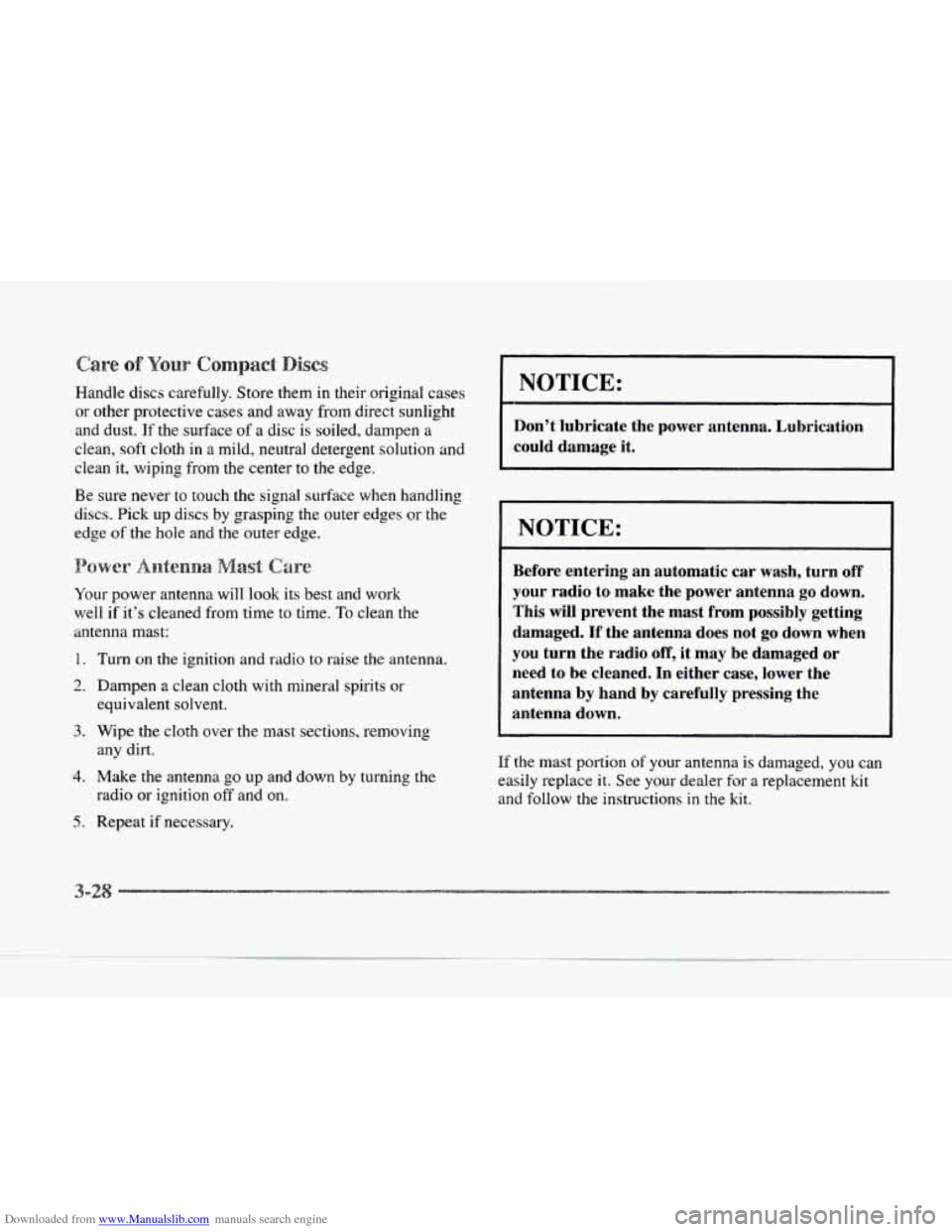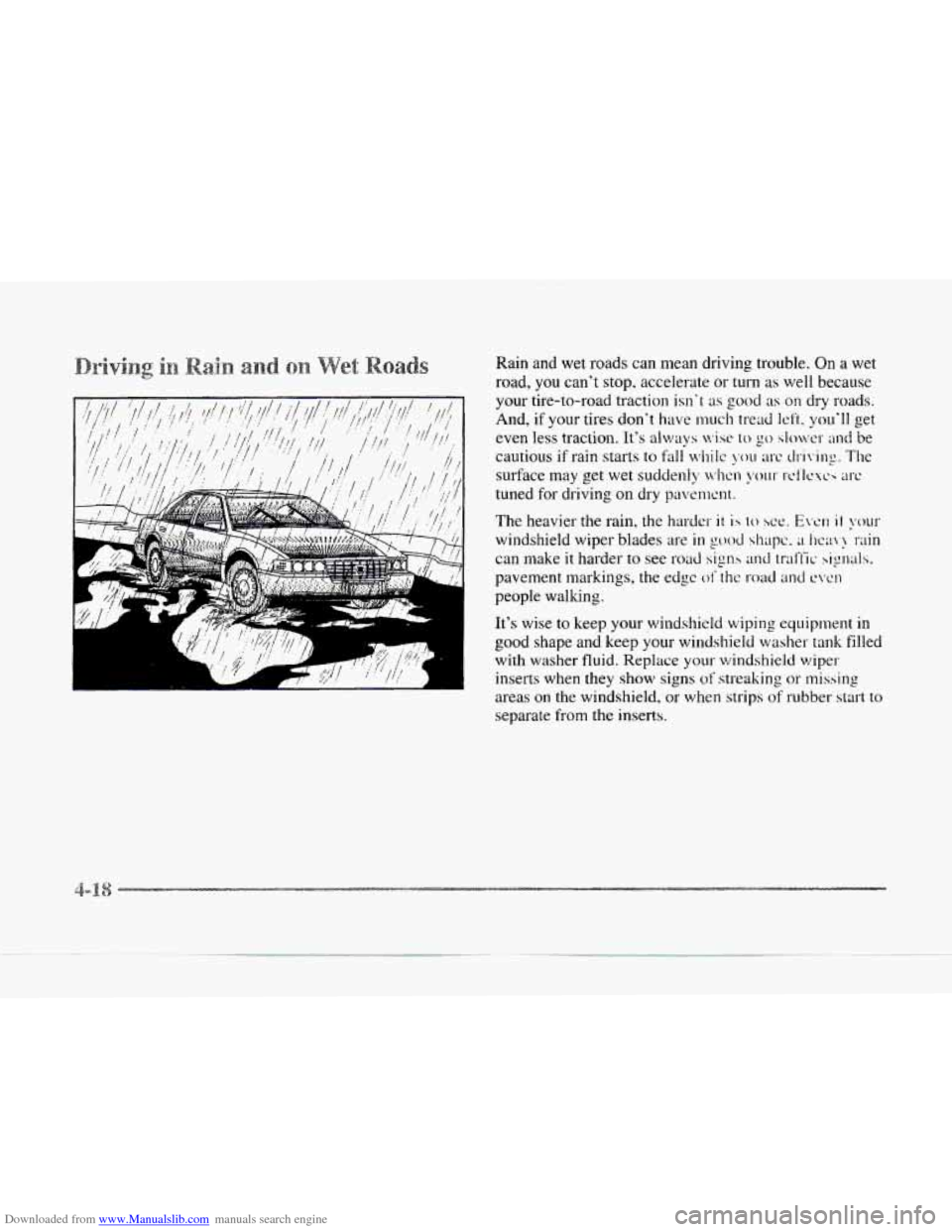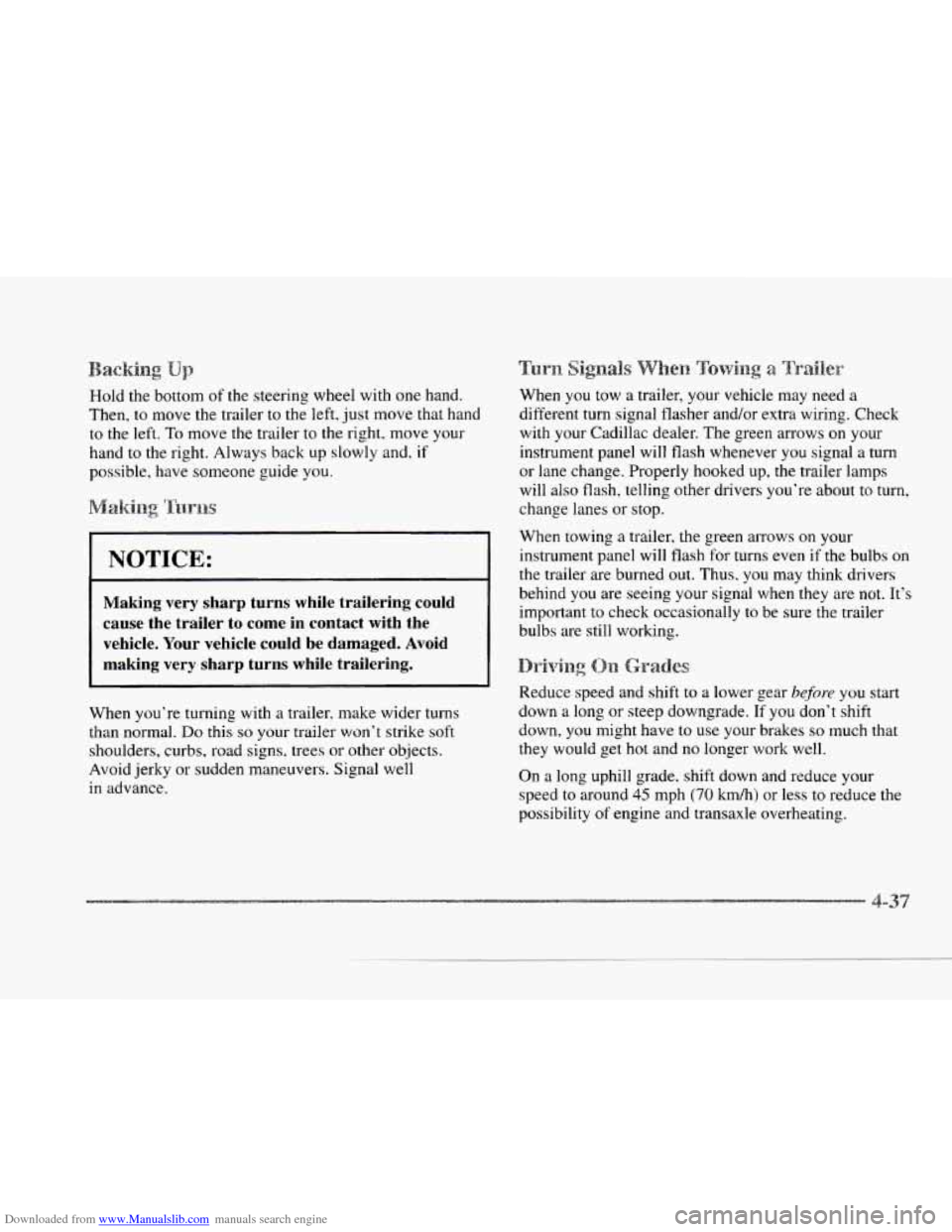Page 187 of 370

Downloaded from www.Manualslib.com manuals search engine Handle discs carefully. Store them in their original cases
or other protective cases and away from direct sunlight
and dust.
If the surface of a disc is soiled, dampen a
clean, soft cloth in a mild, neutral detergent solution and
clean it, wiping from the
center to the edge.
Be sure never
to touch the signal surface when handling
disc-s. Pick up discs by grasping the outer edge.s or the
edge of the hole and
the outer edge.
Your power antenna will
look its best and work
well
if it’s cleaned from time to time. To clean the
antenna mast:
1.
2.
3.
4.
5.
Turn on the ignition and radio to raise the antenna.
Dampen a clean cloth with mineral spirits
or
equivalent solvent.
Wipe the cloth over the mast sections, removing
any dirt.
Make the antenna go up and down by turning the
radio or ignition off and
on.
Repeat if necessary.
I NOTICE:
Don’t lubricate the power antenna. Lubrication
could damage it.
NOTICE:
Before entering an automatic car wash, turn off
your radio to make the power antenna
go down.
This will prevent the mast from possibly getting
damaged.
If the antenna does not go down when
you turn the radio
off, it may be damaged or
need to be cleaned. In either case, lower the
antenna by hand by carefully pressing the
antenna down.
If the mast portion of your antenna is damaged, you can
easily replace
it. See your dealer for a replacement kit
and follow
the instructions in the kit.
Page 205 of 370

Downloaded from www.Manualslib.com manuals search engine 0
0
e
0
Do not get too close to the vehicle you want to pass
while you’re awaiting an opportunity. For one thing,
following
too closely reduces your area of vision,
especially if you’re following a larger vehicle. Also,
you won’t have adequate space if the vehicle
ahead suddenly slows or stops. Keep back a
reasonable distance.
When
it looks like a chance to pass is coming up,
start to accelerate but stay in the right lane and don’t
get
too close. Time your move so you will be
increasing speed as the time comes
to move into the
other lane. If the way
is clear to pass, you will have a
“running start“ that more than makes up for the
distance you would
lose by dropping back. And if
something happens to cause you to cancel your pass,
you need only slow down and drop back again and
wait for another opportunity.
If other cars are fined up to pass a slow vehicle, wait
your turn. But take care that someone isn’t trying to
pass you as you pull out to pass the slow vehicle.
Remember
to glance over your shoulder and check
the blind spot.
Check your mirrors, glance over your shoulder, and
start your left lane change signal before moving
out
of the right lane to pass. When you are far enough
ahead
of the passed vehicle to see its front in your
0
0
e
inside mirror, activate your right lane change signal
and move back into the right lane. (Remember that
your right outside mirror is convex. The vehicle you
just passed may seem
to be farther away from you
than it really is.)
Try not to pass more than one vehicle at
a time on
two-lane roads. Reconsider before passing the
next vehicle.
Don’t overtake a slowly moving vehicle too rapidly.
Even though
the brake lamps are not flashing, it may
be slowing down
or starting to turn.
If you’re being passed, make it easy for the
folIowing driver to get ahead
of you. Perhaps you
can ease a little to the right.
Let’s review what driving experts say about what
happens when the three control systems (brakes, steering
and acceleration) don’t have enough friction where the
tires meet the road to do what the driver has asked.
In any emergency, don’t give up. Keep ttying
to steer and
constantly seek an escape route or area of less danger.
Page 209 of 370

Downloaded from www.Manualslib.com manuals search engine Rain and wet roads can mean driving trouble. On a wet
road, you can't stop. accelerate or turn as well because
your tire-to-road traction isn-t
as good as on dry roads.
And, if your tires don't have much tread left. you'll get
even less traction. It's
always vise to go slower and be
cautious if rain starts to Fall while >~u ;I~C clri\-ing. The
surface
may get wet suddenly ~vhcn \-?our I.C~'~C'NC'~ ~II-C
tuned for driving on dry paven'lcnt.
The heavier the rain, the harder it is to we. E1.w it your
windshield wiper blades are in ~ood shapc. ;I Ilea\,! rain
can make it harder to see road signs and twt'fic signals.
pavement markings, the edge oi' thc ~-oad and e~'ttn
people wallting.
It's wise to keep your windshield wiping equipment in
good shape and keep your windshield washer tank filled
with washer fluid. Replace your
windshield wiper
inserts
when they show signs of streaking or missing
areas on
the windshield. or when strips of rubber start to
separate from the inserts.
Page 212 of 370
Downloaded from www.Manualslib.com manuals search engine r
r
r
r
r
r
r
r
r
One of the biggest problems with city streets is the
amount
of traffic on them. You’ll want to watch out for
what the other drivers are doing and pay attention to
traffk signals. Here
are ways to increase your safety in city driving:
0
0
e
Know the best way to get to where you are
going. Get
a city map and plan your trip into an
unknown
part of the city just as you would for a
cross-country trip.
Try to use the fieeways that rim and crisscross most
large cities. You’ll save time and energy. (See the
next
part, “Freeway Driving.”)
Treat a green light
as a warning signal. A traffic
light is there because
the corner is busy enough to
need it. When a light turns green, and just before
you
start to move, check both ways for vehicles that have
not cleared the intersection
or may be running the
red light.
Page 213 of 370

Downloaded from www.Manualslib.com manuals search engine Mile for mile, freeways (also called thruways, parkways,
expressways, turnpikes or superhighways) are the safest
of all roads. But they have their own special rules.
The most important advice on freeway driving
is: Keep
up with traffic and keep to the right. Drive at the same
speed most
of the other drivers are driving. Too-fast or
too-slow driving breaks
a smooth traffic flow. Treat the
left lane
on a freeway as a passing lane. At
the entrance, there is usually a ramp that leads to the
freeway.
If you have a clear view of the freeway as you
drive along the entrance
ramp, you should begin to
check traffic. Try to determine where you expect to
blend with the flow. Try to merge into the gap at close to
the prevailing speed. Switch on your turn signal, check
your
mirrors and glance over your shoulder as often as
necessary. Try to blend smoothly with the traffic flow.
Once you are on the freeway, adjust your speed to the
posted limit or to the prevailing rate if it’s slower. Stay
in the right lane unless you want to pass.
B.efore changing lanes, check your mirrors. Then use
your turn signal.
Just before you leave, the lane, glance quickly over your
shoulder to make sure there isn’t another vehicle in your
“blind” spot.
Once you are moving
on the freeway, make certain you
allow a reasonable following distance. Expect to move
slightly slower at night.
When you want
to leave the freeway, move to the proper
lane well in advance. If you miss your exit,
do not,
under any circumstances, stop and back up. Drive
on to
the next exit.
The exit ramp can be curved, sometimes quite sharply.
I
Page 228 of 370

Downloaded from www.Manualslib.com manuals search engine L
Hold the bottom of the steering wheel with one hand.
Then,
to move the trailer to the left, just move that hand
to the left. To move the trailer to the right, move your
hand to the right. Always back up
slowly and, if
possible, have someone guide you.
When you tow a trailer, your vehicle may need a
different turn signal flasher and/or extra wiring. Check
with your Cadillac dealer. The green arrows
on your
instrument panel will flash whenever
you signal a turn
or lane change. Properly hooked
up, the trailer lamps
will also flash, telling other drivers you’re about to turn,
change lanes or stop.
When towing
a trailer, the green arrows on your
instrulnent panel will flash for turns even if the bulbs on
the trailer are burned
out. Thus, you may think drivers NOTICE:
Making very sharp turns while trailering could
cause the trailer to come in contact with t,he
vehicle. Your vehicle could be damaged. Avoid
behind you are seeing your signal when they are not. It’s
important to check occasionally to be sure the trailer
bulbs are still working.
making very sharp turns while trailering.
Reduce speed and shift to a lower gear before you start
When you’re turning with
a trailer, make wider turns down a long or steep downgrade. If you don’t shift
than normal.
Do this so your trailer won’t strike soft down, you might have to use your brakes so much that
shoulders, curbs, road signs, trees
or other objects. they would get hot and no longer work well.
Avoid jerky or sudden maneuvers. Signal weil
in advance. On
a long uphill grade.
shift down and reduce your
speed to around
45 mph (70 km/h) or less to reduce the
possibility
of engine and transaxle overheating.
Page 233 of 370
Downloaded from www.Manualslib.com manuals search engine s
Press the button in to *make the front and rear turn signal
lamps flash
on and off.
Your hazard warning flashers let you warn others. They
also
let police know you have a problem. Your front and
rear turn signal lamps will flash on and
off.
a
Y
Page 234 of 370
Downloaded from www.Manualslib.com manuals search engine c
A
This light on the instrument
panel will flash, indicating
that the hazard warning
flashers are
on.
The hazard warning flashers will work once the button
is pressed in regardless
of the key position.
e
Pull out on the collar to turn the flashers off. When the
hazard warning flashers are on. the turn signals won't
work since
they are alreadv flashing.